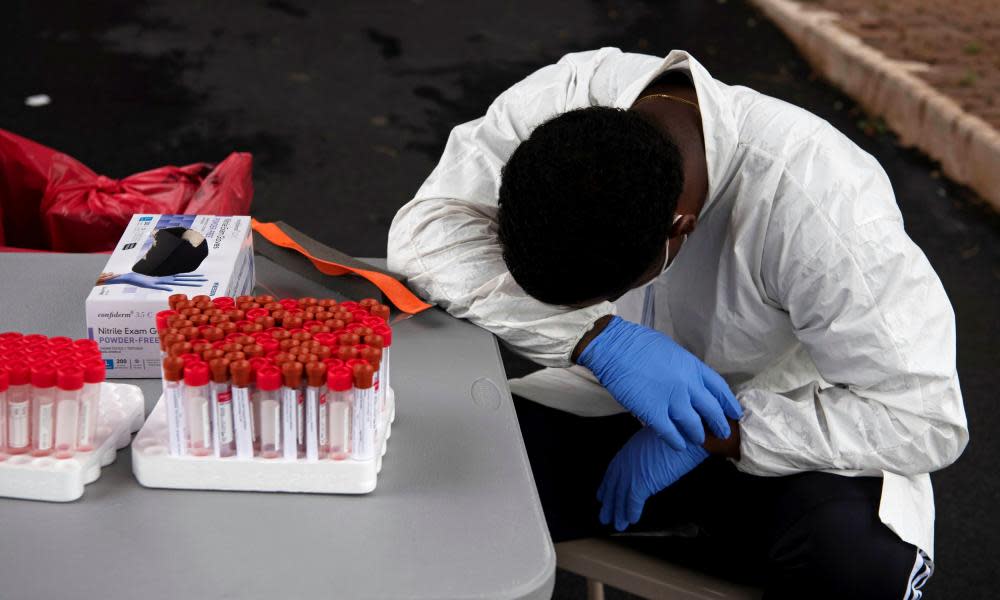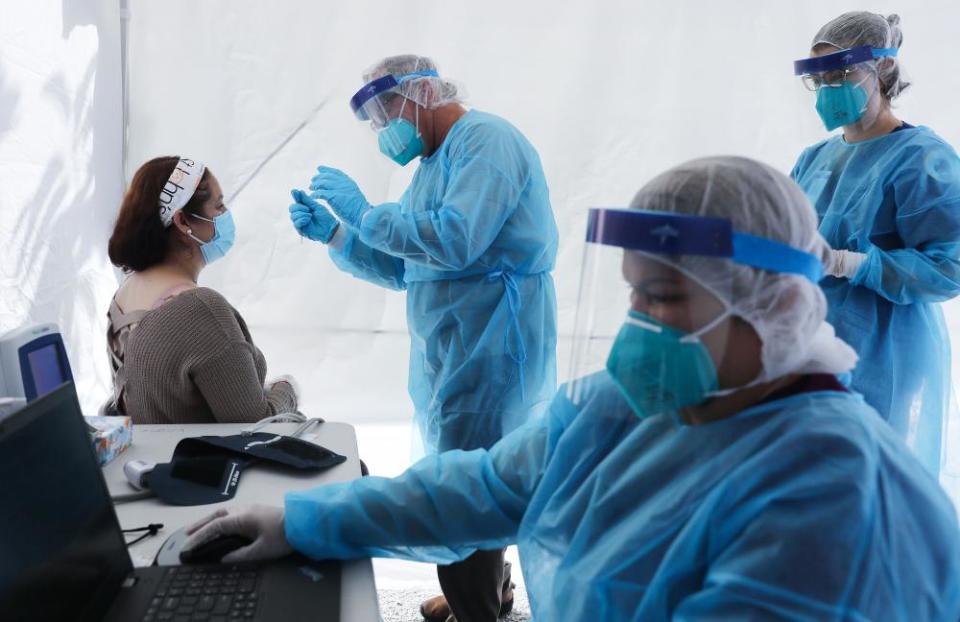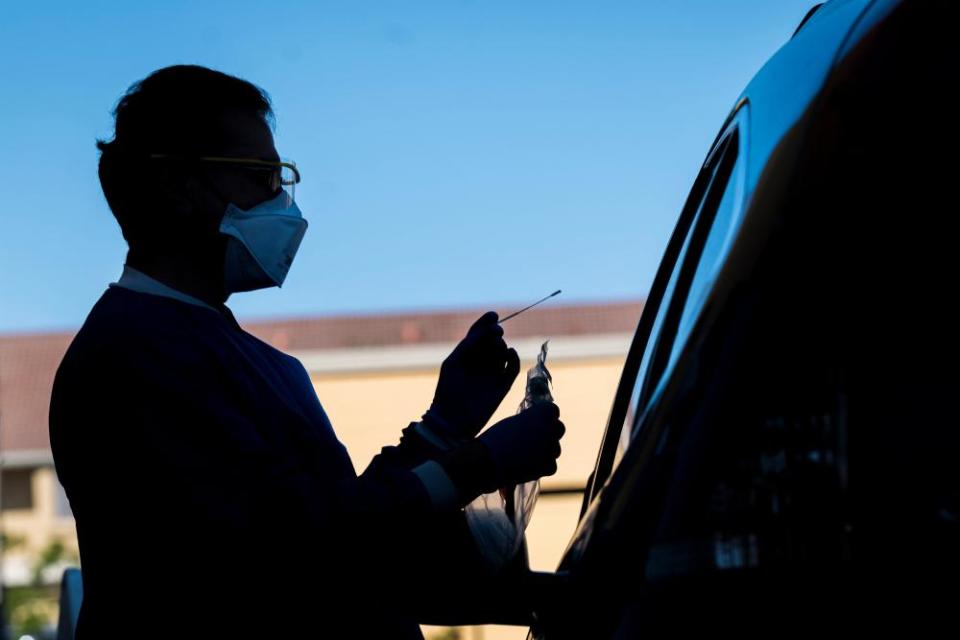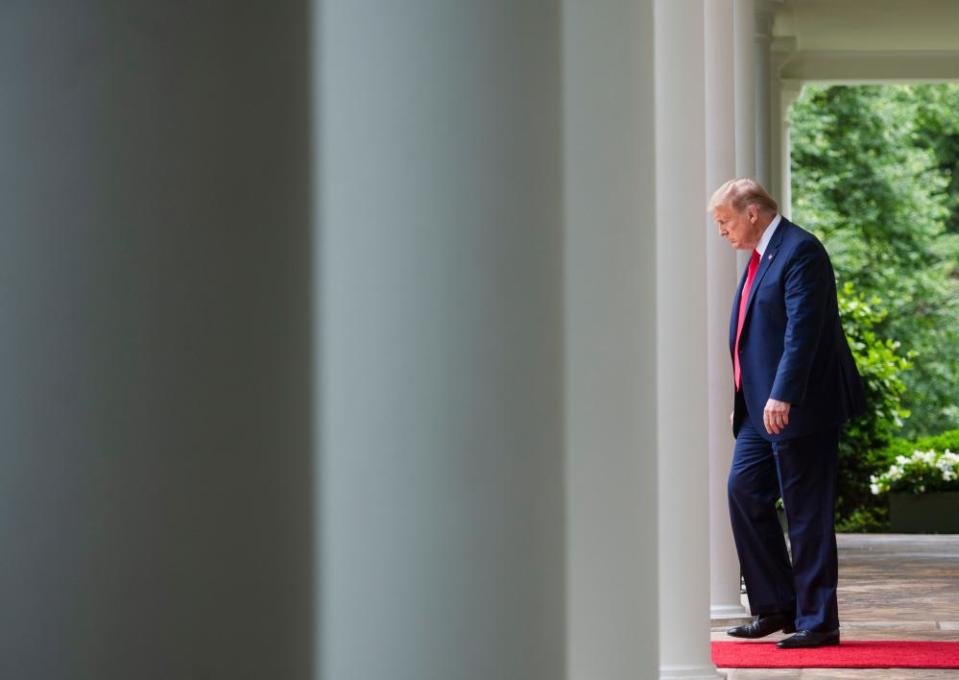After 200,000 coronavirus deaths, the US faces another rude awakening

Donald Trump attended one of his then daily White House coronavirus briefings on 17 April and in a moment of rare candor talked openly about his projections for the number of Americans who could die from the disease.
“Right now, we’re heading at probably around 60, maybe 65,000,” he said, adding: “One is too many. I always say it: One is too many.”
If one death from coronavirus is too many, then the president of the United States has a lot of explaining to do. His projection of a total 60,000 death toll was passed by 1 May, just two weeks after he made it.
By the end of that month the grim landmark of 100,000 deaths was surpassed. Now less than four months later the toll has doubled again, the virus crossing the 200,000 point with breezy abandon.

There is a Groundhog Day quality to the American experience of Covid-19. Back in March there was public outcry that, under Trump, protective gear to keep health workers safe was in critically short supply, testing for coronavirus was woefully inadequate and black Americans were dying in grotesquely disproportionate numbers.
Today, six months later, exactly the same laments can be heard. “There is a theme here,” said Eric Topol, professor of molecular medicine at Scripps Research in San Diego. “Recreate the crime. We keep on doing it, over and over again.”
With autumn on the horizon, when colder weather is likely to drive millions back indoors where the virus can spread more easily and with returning colleges acting as giant disease incubators, the US is poised for another rude awakening. There is simply no chance of containing the contagion when new cases are still running at about 35,000 a day.
We’re on track to have a quarter-million dead Americans by the end of the year with absolutely no reason it had to happen
Jeremy Konyndyk
In March the Guardian asked Jeremy Konyndyk, a senior policy fellow at the Center for Global Development who was at the forefront of the US government response to Ebola in 2014, to give his take on how the pandemic was being handled. He called the Trump administration’s effort “one of the greatest failures of basic governance in modern times”.
We went back to Konyndyk to ask how he sees it now as the country passes the devastating 200,000 deaths mark. “I think my analysis has borne out extremely well,” he said. “We’re on track to have a quarter-million dead Americans by the end of the year with absolutely no reason it had to happen. It was all preventable. So yes, this is a leadership failure of astounding proportions.”
Personal protective equipment (PPE)
When the number of coronavirus infections began rising in the US in March, the failure of the Trump administration quickly to mobilise a national response led to dire shortages of protective gear across the country. Hospital workers and other essential staff were exposed to personal danger after inadequate supplies of masks, gowns and disinfectants ran out, leading some medical staff to improvise PPE out of piles of fabric and prompting nurses to protest outside the White House.
PPE shortages were one important factor behind the tragic loss of life among health workers. The Guardian’s project with Kaiser Health News, Lost on the frontline, has identified 1,150 medical workers who have died of Covid-19 having contracted the virus on the job.
Despite such tragedies, the US is still remarkably unprepared. The president of the American Medical Association, Susan Bailey, said last week that critical PPE shortages persist, “and in many ways things have only gotten worse”.
In many hospital systems, including Scripps Health in San Diego where Topol is based, the most effective form of protection, N95 masks, are still being rationed.
“Why the Trump administration, which has spent trillions of dollars bailing out companies, has not invested in protecting Americans with the best protection we can provide, is a mystery to me,” Topol said.
Testing
The US has struggled to provide sufficient diagnostic testing for the virus since the start of the pandemic. From the outset, Trump was reluctant to engage the federal government in a nationwide push for testing on a scale that could contain the disease.
As a result, US testing remains inadequate to this day, with still no sign of any attempt by the Trump administration to fix the problem. In fact, the quantity of daily testing is actually falling, down from more than 800,000 tests a day in July to about 600,000 daily tests now.
Daily testing falls grossly short of the capability of 20m tests a day that Harvard’s Edmond Safra Center has estimated is needed for safe and effective reopening of the economy.

The individual components of a coronavirus test also remain in short supply. “There aren’t enough swabs, there aren’t enough reagents, we haven’t invested in the rapid home test that should have been available by now,” Topol said.
The dearth of testing can directly be linked to Trump’s opposition to it. The US president has consistently stood in the way of more testing, arguing it leads to a higher count of confirmed cases which is bad for his political standing.
In fact, the scientific understanding is the opposite: if you increase testing, that will allow you eventually to bring down the case count – and death toll – by allowing you to identify and isolate infected individuals.
Trump has imposed his resistance to testing on the country’s leading public health agency. Last month the Centers for Disease Control and Prevention (CDC), under its director, Dr Robert Redfield, changed its official recommendations having been leant on by the White House.
The new guidelines say that people showing no symptoms of Covid-19 need not be tested. That flies in the face of scientific thinking – asymptomatic individuals are precisely those who need testing most as they can infect others undetected.
“It’s mind-boggling,” Konyndyk said. “I have no idea how Redfield has not yet resigned. He’s been party to policies that are utterly indefensible.”
Consistent messaging
Public health experts stress that consistent and clear messaging is critical in fighting a pandemic. Trump’s messaging has at least been largely consistent, but it has also been fatally misleading.
From the start, the president downplayed the severity and danger of the virus and disparaged simple methods of reducing its spread including masks – refusing to wear a mask in public until 11 July. He predicted coronavirus would miraculously disappear, a claim that he has repeated in various guises right up to last week when he said that America was “rounding the corner”.

We now know that Trump’s soothing talk was a lie to the American people. Taped interviews released by the journalist Bob Woodward for his new book, Rage, record Trump in February admitting he knew full-well that the virus was “deadly stuff” and that he played it down “because I don’t want to create a panic”.
Not wanting to create panic is one thing. Failing to act to prevent the deaths of potentially hundreds of thousands of Americans quite another.
Racial disparities
One of the most distressing aspects of the Covid disaster in the US has been the way the disease has disproportionately affected African American and other racial and ethnic minorities.
Data suggests that, nationwide, black people are between two and three times more likely to die from Covid-19 than white Americans. In some parts of the US the gulf is even more pronounced, with Latinos in Minnesota testing positive for the virus at seven times the per-capita rate of white people.
The Trump administration has tried to dismiss the racial inequity of Covid outcomes by blaming it on underlying co-morbidities such as obesity, diabetes and high blood pressure. Health experts, however, have called for a deeper look at what lies behind those co-morbidities, which often flourish among poverty.
Minority groups are more likely to be living in cramped housing where the virus can easily spread, and frontline workers consisting disproportionately of minorities are often forced to carry on working away from home even at times of peak contagion. Questions have also been raised about whether African Americans are given equal access to testing and medical treatment.
Although these racial disparities were revealed early on in the pandemic, the Trump administration appears to have done little to try and address them. The CDC has been criticized for failing to record up-to-date and comprehensive records on Covid-19 cases and deaths by racial group.
Vaccine
The one area where the federal government has been aggressively active in response to the pandemic has been in pressing for rapid approval of any coronavirus vaccine. Trump launched Operation Warp Speed in May and since then has repeatedly promised early access to a vaccine, predicting it might even be ready – conveniently – before the 3 November presidential election.
We have an FDA who is complicit by issuing false and reckless approvals
Eric Topol
Trump’s use of the prospect of a vaccine as an electoral tool has raised fears that he is politicizing the Food and Drug Administration (FDA), the federal agency that will have the ultimate power to approve or withhold any new vaccine. Topol pointed out that the FDA’s commissioner, Stephen Hahn, has already made two basic breaches of scientific protocol.
He granted emergency approval for hydroxychloroquine after Trump claimed inaccurately that it was a “miracle drug”. Hahn also gave out false information for which he later apologized at a Trump press conference hailing a “historic breakthrough” over convalescent plasma.
“We have an FDA who is complicit by issuing false and reckless approvals. That’s not a good foundation for making the biggest public health decision for generations – whether or not to approve a vaccine,” Topol said.
Any misstep on the part of the Trump administration in handling the rollout of a vaccine could have drastic consequences. Anxiety about the safety or efficacy of a vaccine is already running high, with 35% of Americans in a recent Gallup poll saying they would not agree to be vaccinated even were the product free and fully FDA-approved.

 Yahoo News
Yahoo News 
